MSI GE60 Review: Mainstream Mobile Maxwell
by Jarred Walton on July 17, 2014 5:00 AM ESTMSI GE60 LCD: Surprisingly Good
I'll be honest: before actually seeing the GE60 in person, I wasn't expecting too much from the display. It's not that MSI has a reputation for using terrible LCD panels in their laptops, but the GT70 as one example is still sporting a TN panel even on the latest version. Thus, I was more than a little surprised to find that "lesser" GE60 using a Samsung PLS display, and while the out-of-box color accuracy could still be improved quite a bit, post-calibration the display performs exceptionally well. And even if you're not a stickler for accurate colors, the improved viewing angles offered by PLS/IPS/AHVA/etc. panels make using the laptop much more viable in cramped quarters (e.g. on a plane).
Full results for the display testing are in Notebook Bench, as well as in the galleries below; the charts mostly reflect the highlight right now (as we haven't tested very many laptops with the new software/hardware). But let's start with the core characteristics: white level, black level, and contrast.
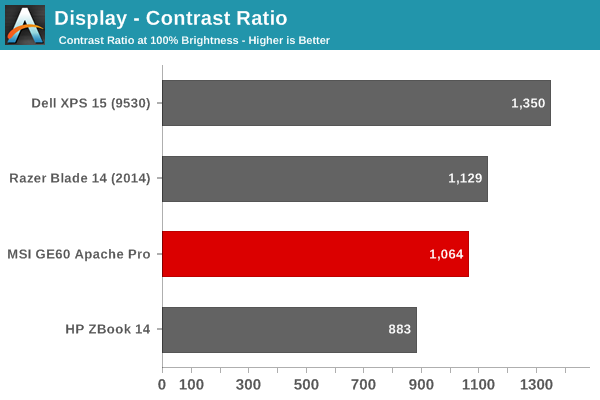
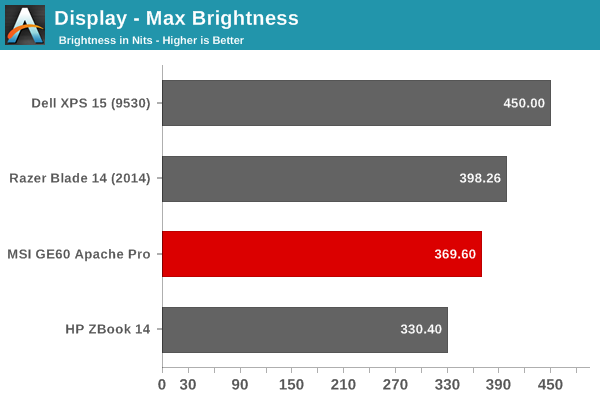
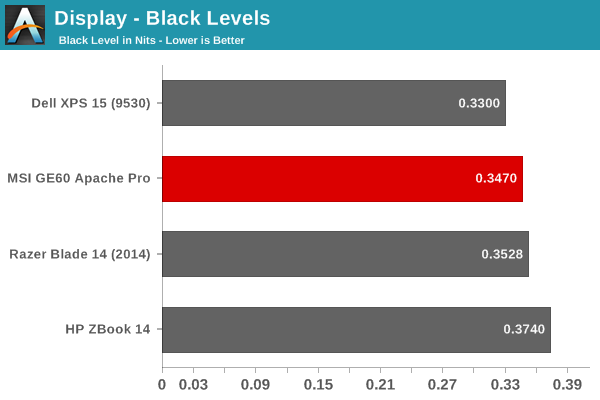
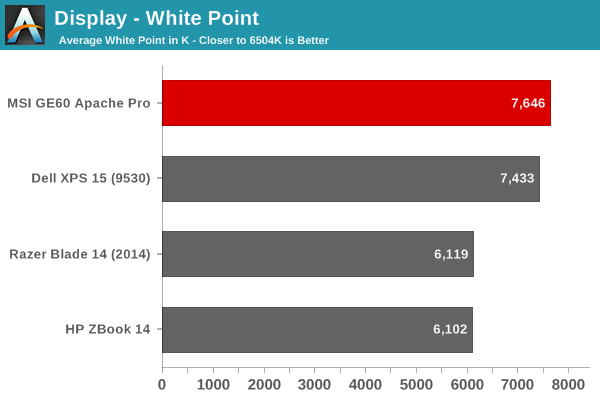
The white level of 370 cd/m2 is a good starting point, and with a black level of 0.3472 nits at max brightness we end up with a contrast ratio of 1064:1. That's not the best result that we've ever seen from a laptop, but it is quite good – even more so considering the display has an anti-glare coating (glossy displays tend to have a bit higher contrast). Dropping the brightness to 54% gives us a 200 nits white level with a 1016:1 contrast, so it's a bit lower but still good. The problem is the native white point is around 7650K, which is far from the "ideal" 6504K, so there's a definite blue tint to the colors. That brings us to the full uncalibrated results:
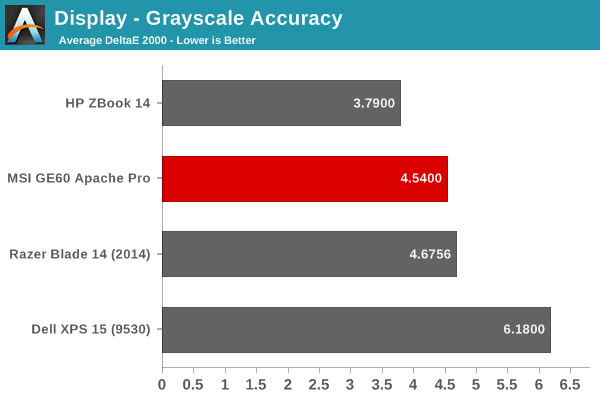
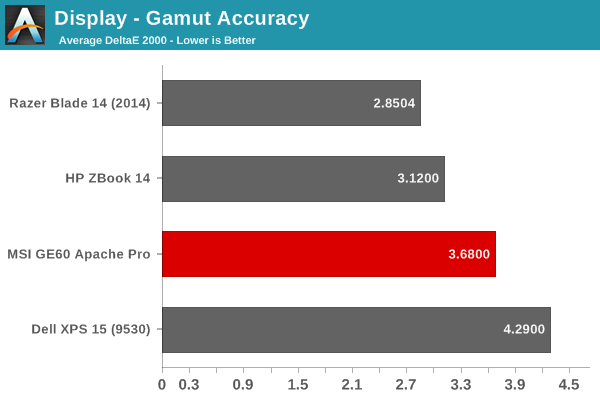
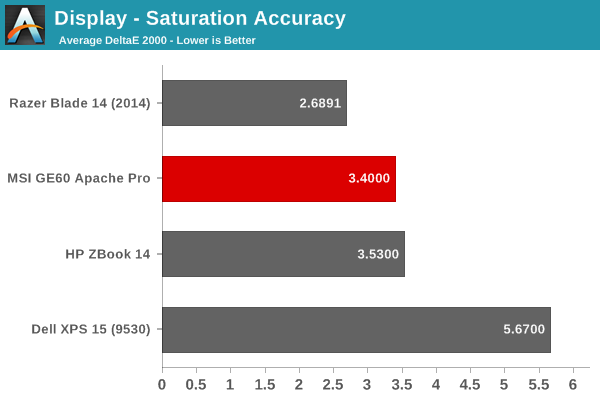

Grayscale results are good up until about 40%, at which point the errors start to become visible. By 50% the Delta E has increased to over 5, and by 75% dE is nearly 10. That's really not a very good result, though I've certainly seen worse (e.g. MSI's GT70 LCD had errors above 12 before calibration). Results in the other charts tell a similar story. While the average dE may only be in the range of 4.5 or so, there are many spikes into the high single digits – mostly in the reds, oranges, and yellows, but shades of green a blue also show some significant errors.
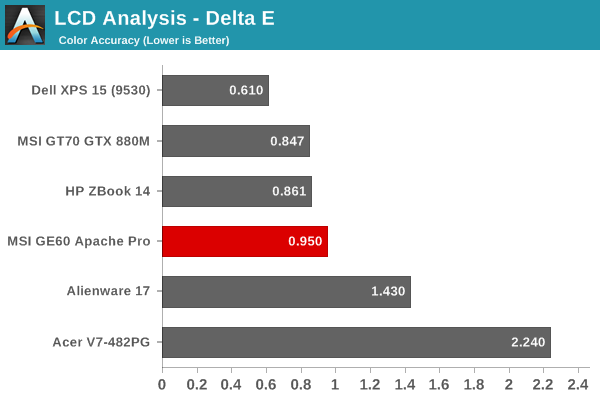
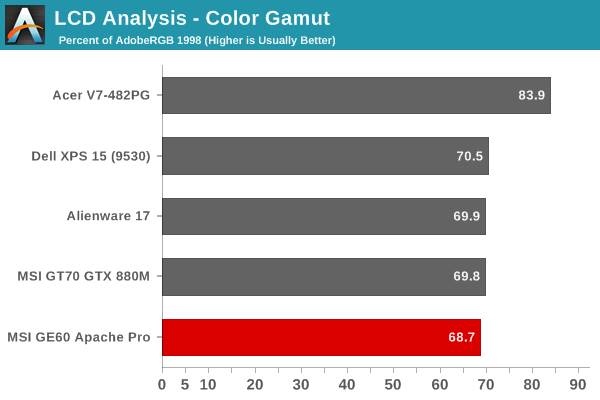
Post-calibration is a different story; the gamma, RGB balance, and color accuracy improve dramatically, to the point where there are very few errors even reaching 2.0. If you have the proper tools to calibrate the display, the GE60 can definitely suffice for professional work. The color gamut is also pretty close to the sRGB standard (it's 68.7% of AdobeRGB compared to a 72% target for sRGB), so outside of users who need high color depth it will work well.



























63 Comments
View All Comments
pierrot - Thursday, July 17, 2014 - link
Wheres that desktop 860? Preferably something that will fit in an ITX case!koekkoe - Thursday, July 17, 2014 - link
It's called 750 Ti.Anonymous Blowhard - Thursday, July 17, 2014 - link
It also comes in low-profile for those really tight spaces.odell_wills - Thursday, October 9, 2014 - link
I love it! /Odell from http://www.consumertop.com/best-laptop-guide/Samus - Thursday, July 17, 2014 - link
I run a 750Ti in my Haswell i5 gaming PC. Pretty impressive for a card that runs completely off the PCIe bus power. It runs BF4 at 1900x1200 always above 60FPS at a mix of Medium and High.I'd say its somewhere between a 560Ti and 660.
Frenetic Pony - Thursday, July 17, 2014 - link
The problem with Maxwell and desktop in general is that Maxwell is to GPUs what Haswell was to CPUs, an almost entirely mobile/battery life concentrated update. Which means if you're plugging something in just buy whatever because Maxwell isn't going to do you much better.smorebuds - Thursday, July 17, 2014 - link
Except for the mobile variants like the 860M, which is the entire point of the article you're commenting on. Just like with Haswell, for the same or better performance devices can be thinner, lighter, and last longer.smorebuds - Thursday, July 17, 2014 - link
And I realize you're not necessarily referring to mobile, but the analogy still applies to desktop. I think everyone would prefer a smaller, quieter, and less power-hungry box in their room.DanNeely - Monday, July 21, 2014 - link
With gaming desktops I suspect more people would turn around and spend all the increased performance/watt on more performance instead of fewer watts.Antronman - Thursday, July 17, 2014 - link
Well actually, the new mobile maxwells have far better performance, because they were able to put more cores into the gpus and clock them slightly higher due to the much lower TDP.Who's to say the same won't happen with desktop GPUs?